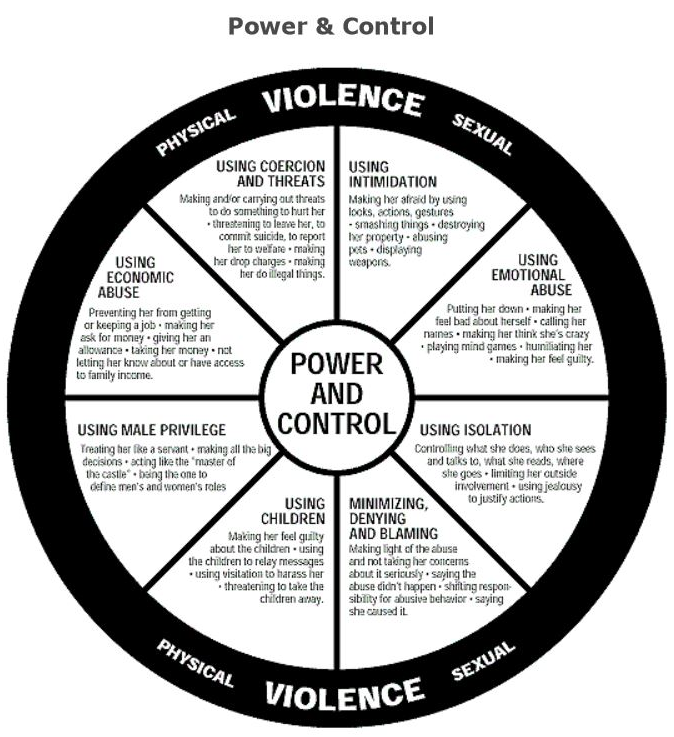
The U.S. Navy’s Bureau of Medicine and Surgery aims to excise a foe — one that supposedly exists within the service itself: “male privilege.” The endeavor is outlined in a new Navy document on healthy vs. unhealthy male-female relationships, which includes charts called the “Power & Control” wheel (shown below the quote) and the “Equity Wheel.” It’s the latest in the military social engineering that critics warn is transforming our armed forces into a wheel of misfortune.
Writes the American Mirror:
The wheel lists “common phrases victims use when describing their abuse,” which includes “male privilege,” the Social Memo reports.
The “male privilege” portion of the Power and Control Wheel includes these examples:
“Treating her like a servant”
“Making all the big decisions”
“Acting like the ‘master of the castle’”
“Being the one to define men’s and women’s roles”
The narrative document lists these stereotypical examples of “male privilege”:
“He refuses to pick up milk on his way home because it’s ‘women’s work.’”
“When he came home yesterday, he was driving a brand new truck. I told him we needed something the whole family could fit in, but he didn’t listen to me.”
“He doesn’t mind his friends being at the house at all hours of the night, but he says my Sunday brunch friends talk too much and are no longer welcome.”
 The notion of “male privilege” is reminiscent of “white privilege” theory, which is taught at colleges and is now a popular seminar topic. And like that theory, the notion of male privilege has a basis not in reality but ideology. Consider domestic violence. While the Navy document apparently gives men the privilege of being portrayed as only its perpetrators, the American Mirror cites a 2012 study indicating that 53 percent of domestic-abuse victims are men. And literally scores of other studies — over the course of decades — have found that women are in fact more likely to initiate violence in relationships. This may seem counterintuitive, but as I explained last year, “Observers point out that some women will take advantage of domestic-violence laws and procedures, knowing that if a man they assault retaliates, calling the police will generally result in the onus being placed on him. In addition, increased female domestic assault is part and parcel of a decades-long rise in female violence in general.” Moreover, I continued, “Boys to a great degree are still raised with the prohibition ‘You don’t hit girls’; there is no corresponding prohibition for females, however, and they’re no longer raised with the companion teaching, ‘Ladies don’t hit at all.’ …Being ladylike is viewed today as existence in a patriarchal pillory.”
The notion of “male privilege” is reminiscent of “white privilege” theory, which is taught at colleges and is now a popular seminar topic. And like that theory, the notion of male privilege has a basis not in reality but ideology. Consider domestic violence. While the Navy document apparently gives men the privilege of being portrayed as only its perpetrators, the American Mirror cites a 2012 study indicating that 53 percent of domestic-abuse victims are men. And literally scores of other studies — over the course of decades — have found that women are in fact more likely to initiate violence in relationships. This may seem counterintuitive, but as I explained last year, “Observers point out that some women will take advantage of domestic-violence laws and procedures, knowing that if a man they assault retaliates, calling the police will generally result in the onus being placed on him. In addition, increased female domestic assault is part and parcel of a decades-long rise in female violence in general.” Moreover, I continued, “Boys to a great degree are still raised with the prohibition ‘You don’t hit girls’; there is no corresponding prohibition for females, however, and they’re no longer raised with the companion teaching, ‘Ladies don’t hit at all.’ …Being ladylike is viewed today as existence in a patriarchal pillory.”
In keeping with this is a study finding that coupling women creates a particularly volatile mix: While only 11 percent of heterosexual couples report violence in their relationships, a whopping 53 percent of lesbian couples do.
And men are taking hits academically and economically, too. Feminists often complained in the ’90s about how society’s supposed destruction of girls’ self-esteem was hurting them educationally, yet girls had already long been getting better grades than boys, partially due to feminized curricula and undisciplined school environments. Today, 56 percent of college undergraduates are women, with women being 33 percent more likely than men to receive college degrees. And this sex gap is even greater among blacks and Hispanics.
Despite this, Title IX — the unconstitutional federal legislation that supposedly prohibits “discrimination based on sex in education programs or activities that receive Federal financial assistance” — is applied only to educational areas in which men predominate. It has decimated some men’s college sports (such as wrestling), as bureaucrats have interpreted it as prescribing “proportionality”; this mean that if a student body is 60 percent female, 60 percent of the college’s athletes must be women even if men are more interested in athletics. Many leftists also aim to apply this principle to science, technology, engineering, and math (the STEM fields), which are still dominated by men; after all, academics is more important than athletics. Given this, however, shouldn’t the “moral imperative” of proportionality be applied to college enrollment in the first place, to achieve a male-female ratio that reflects the wider population? Equality, right?
But what of the intersex wage gap indicating that women earn only 77 cents on a man’s dollar? Isn’t that an example of male privilege? This statistic is explained by the statistics behind it: Men generally work longer hours than women, are more likely to accept promotions, bring more years of experience to a job, and enter more lucrative fields (e.g., are more likely to pursue the hard sciences, whereas women gravitate toward the soft ones). In contrast and as writer Carrie Lukas pointed out, women tend to value flexibility, convenience, and personal fulfillment over money when choosing a job. And these choices are apparently influenced by innate sex differences, as the excellent Norwegian documentary The Gender Equality Paradox illustrates.
Moreover, as I wrote last year in “Equal Pay for Equal Work: Means Paying Men More”:
Some groups of American women are putting more bread on the table than their male cohorts. For example, consider what an April 8 PunditFact Truth-O-Meter article reported about research conducted by James Chung of private research firm Reach Advisors:
The median full-time salaries of young women in America’s metropolitan areas are 8 percent higher than those of the guys in their peer group.
A breakdown provided for Time magazine included a look at specific cities. In Atlanta, young unmarried childless women made 21 percent more than men, Chung found. In Los Angeles, young women made 12 percent more than their cohorts.
PunditFact states that the “reason why young women in metropolitan areas earn more than young men is that they are 50 percent more likely to graduate from college,” yet there’s another factor. As writer Carey Roberts wrote in 2008:
According to the National Association of Colleges and Employers, in many fields female college grads are being offered higher starting salaries than their male counterparts.
Female physicists are getting $6,500 more [than men are]. Co-eds who majored in petroleum engineering are being offered $4,400 more. And women computer programmers are being enticed with $7,200 extra pay. In fact for dozens of majors and occupations, women coming out of college are getting better offers than men….
Why these disparities? Because in traditionally male-dominated professions, employers are willing to ante up more greenbacks to attract females in order to forestall a costly discrimination lawsuit.
Of course, in our equality-obsessed world, only men have to register for selective service. Men are also 93% of those killed on the job; pay more into Social Security but receive less in benefits (because women live longer); and pay more for insurance when they cost the system more, such as with auto insurance, but the same for insurance when they cost the system less, such as under ObamaCare. As for the Navy, it announced July 2 that maternity leave time would be tripled to 18 weeks to better accommodate female service members, but yet doesn’t offer paternity leave to men.
My, being privileged just ain’t what it used to be.


